Global Warming and Its Effect on Binder Performance Grading in the USA: Highlighting Sustainability Challenges
Abstract
:1. Introduction
2. Methods and Data Preparation
2.1. Data Preparation: Temperature and PG Calculation
2.2. Methodology: Time Series Models
3. Results
3.1. Prediction of Average 7-Day Maximum and Minimum Air Temperature
3.2. Binder Performance Grade (PG) Selection
4. Discussion
5. Conclusions
- Using time series models to forecast temperature changes up to 2060, substantial increases in both maximum and minimum air temperatures across the majority of states are projected. Specifically, 38 out of 50 states are expected to experience rising maximum temperatures, with Oregon, Utah, and Idaho facing the most significant increases. Concurrently, 33 states are anticipated to see higher minimum temperatures, notably in Maine, North Carolina, and Virginia.
- The widening gap between the required high and low PG values presents a critical challenge, as some essential binders may not be producible or substitutable with other grades. This situation necessitates the use of modifiers to achieve the desired PG properties, bringing additional considerations regarding energy consumption and CO2 emissions. While modified binders may incur higher initial costs and environmental impacts, their improved performance can lead to long-term savings and reduced environmental footprints.
- By integrating life cycle cost analysis (LCCA) and life cycle assessment (LCA) methodologies, this study provides a comprehensive understanding of the economic and environmental implications of various binder modifications. This integrated approach is essential for optimizing construction and maintenance strategies to enhance the durability and serviceability of pavements while minimizing emissions.
- This study emphasizes the need for proactive adaptation strategies in pavement design to address the mounting impacts of climate change, ensuring the long-term resilience of infrastructure in the United States.
6. Limitations and Assumptions
Author Contributions
Funding
Data Availability Statement
Conflicts of Interest
References
- Duchenne-Moutien, R.A.; Neetoo, H. Climate change and emerging food safety issues: A review. J. Food Prot. 2021, 84, 1884–1897. [Google Scholar] [CrossRef] [PubMed]
- Naseri, H.; Ehsani, M.; Golroo, A.; Moghadas Nejad, F. Sustainable pavement maintenance and rehabilitation planning using differential evolutionary programming and coyote optimisation algorithm. Int. J. Pavement Eng. 2022, 23, 2870–2887. [Google Scholar] [CrossRef]
- Satterthwaite, D. The implications of population growth and urbanization for climate change. Environ. Urban. 2009, 21, 545–567. [Google Scholar] [CrossRef]
- Oreggioni, G.D.; Ferraio, F.M.; Crippa, M.; Muntean, M.; Schaaf, E.; Guizzardi, D.; Solazzo, E.; Duerr, M.; Perry, M.; Vignati, E. Climate change in a changing world: Socio-economic and technological transitions, regulatory frameworks and trends on global greenhouse gas emissions from EDGAR v. 5.0. Glob. Environ. Chang. 2021, 70, 102350. [Google Scholar] [CrossRef]
- Ekwurzel, B.; Boneham, J.; Dalton, M.W.; Heede, R.; Mera, R.J.; Allen, M.R.; Frumhoff, P.C. The rise in global atmospheric CO2, surface temperature, and sea level from emissions traced to major carbon producers. Clim. Chang. 2017, 144, 579–590. [Google Scholar] [CrossRef]
- Raftery, A.E.; Zimmer, A.; Frierson, D.M.; Startz, R.; Liu, P. Less than 2 C warming by 2100 unlikely. Nat. Clim. Chang. 2017, 7, 637–641. [Google Scholar] [CrossRef] [PubMed]
- Anderson, D.A.; Christensen, D.W.; Bahia, H.U.; Dongre, R.; Sharma, M.G.; Antle, C.E.; Button, J. Binder Characterization and Evaluation, Volume 3: Physical Characterization; Strategic Highway Research Program, National Research Council: Washington, DC, USA, 1994. [Google Scholar]
- Bahia, H.U.; Anderson, D.A. Strategic highway research program binder rheological parameters: Background and comparison with conventional properties. Transp. Res. Rec. 1995, 8, 32–39. [Google Scholar]
- Kennedy, T.W.; Huber, G.A.; Harrigan, E.T.; Cominsky, R.J.; Hughes, C.S.; Von Quintus, H.; Moulthrop, J.S. Superior Performing Asphalt Pavements (Superpave): The Product of the SHRP Asphalt Research Program; National Research Council: Washington, DC, USA, 1994. [Google Scholar]
- Petersen, J.C.; Robertson, R.E.; Branthaver, J.F.; Harnsberger, P.M.; Duvall, J.J.; Kim, S.S.; Anderson, D.A.; Christiansen, D.W.; Bahia, H.U. Binder Characterization and Evaluation; National Research Council: Washington, DC, USA, 1994; Volume 1. [Google Scholar]
- Yusoff, N.I.; Shaw, M.T.; Airey, G.D. Modelling the linear viscoelastic rheological properties of bituminous binders. Constr. Build. Mater. 2011, 25, 2171–2189. [Google Scholar] [CrossRef]
- Aflaki, S.; Tabatabaee, N. Proposals for modification of Iranian bitumen to meet the climatic requirements of Iran. Constr. Build. Mater. 2009, 23, 2141–2150. [Google Scholar] [CrossRef]
- Viola, F.; Celauro, C. Effect of climate change on asphalt binder selection for road construction in Italy. Transp. Res. Part D Transp. Environ. 2015, 37, 40–47. [Google Scholar] [CrossRef]
- Delgadillo, R.; Arteaga, L.; Wahr, C.; Alcafuz, R. The influence of climate change in Superpave binder selection for Chile. Road Mater. Pavement Des. 2020, 21, 607–622. [Google Scholar] [CrossRef]
- Swarna, S.T.; Hossain, K. Asphalt binder selection for future Canadian climatic conditions using various pavement temperature prediction models. Road Mater. Pavement Des. 2023, 24, 447–461. [Google Scholar] [CrossRef]
- Sheng, J.; Miao, Y.; Wang, L. An Assessment of the Impact of Climate Change on Asphalt Binder Selection in East China Based on the ARIMA Model. Sustainability 2023, 15, 15667. [Google Scholar] [CrossRef]
- El Haloui, Y.; Sepaspour, R.; Hajikarimi, P.; Moghadas Nejad, F.; Fakhari Tehrani, F.; Absi, J. Adoption of Asphalt Binder Performance Grades for Morocco Considering Climate Change. Int. J. Civ. Eng. 2023, 21, 1061–1075. [Google Scholar] [CrossRef]
- Hulme, M.; Brown, O. Portraying climate scenario uncertainties in relation to tolerable regional climate change. Clim. Res. 1998, 10, 1–4. [Google Scholar] [CrossRef]
- Hulme, M.; Viner, D. A climate change scenario for the tropics. Clim. Chang. 1998, 39, 145–176. [Google Scholar] [CrossRef]
- Zebarjadian, F.; Dolatabadi, N.; Zahraie, B.; Yousefi Sohi, H.; Zandi, O. Triple coupling random forest approach for bias correction of ensemble precipitation data derived from Earth system models for Divandareh-Bijar Basin (Western Iran). Int. J. Climatol. 2024, 44, 2363–2390. [Google Scholar] [CrossRef]
- Sarraf, A.; Vahdat, S.F.; Behbahaninia, A. Relative humidity and mean monthly temperature forecasts in Ahwaz Station with ARIMA model in time series analysis. In Proceedings of the International Conference on Environment and Industrial Innovation IPCBEE, Frankfurt, Germany, 28–30 June 2011; IACSIT Press: Singapore, 2011; Volume 12. [Google Scholar]
- Nury, A.H.; Koch, M.; Alam, M.J. Time series analysis and forecasting of temperatures in the sylhet division of bangladesh. In Proceedings of the 4th International Conference on Environmental Aspects of Bangladesh (ICEAB), Kitakyushu, Japan, 24–26 August 2013; pp. 24–26. [Google Scholar]
- Papacharalampous, G.; Tyralis, H.; Koutsoyiannis, D. Predictability of monthly temperature and precipitation using automatic time series forecasting methods. Acta Geophys. 2018, 66, 807–831. [Google Scholar] [CrossRef]
- Box, G.E.; Jenkins, G.M.; Reinsel, G.C.; Ljung, G.M. Time Series Analysis: Forecasting and Control; John Wiley Sons: Hoboken, NJ, USA, 2015. [Google Scholar]
- Lu, P.; Tolliver, D. Pavement treatment short-term effectiveness in IRI change using long-term pavement program data. J. Transp. Eng. 2012, 138, 1297–1302. [Google Scholar] [CrossRef]
- Carvalho, R.; Ayres, M.; Shirazi, H.; Selezneva, O.; Darter, M. Impact of Design Features on Pavement Response and Performance in Rehabilitated Flexible and Rigid Pavements; Turner-Fairbank Highway Research Center: McLean, VA, USA, 2011. [Google Scholar]
- Elkins, G.E.; Schmalzer, P.N.; Thompson, T.; Simpson, A. Long-Term Pavement Performance Information Management System: Pavement Performance Database User Reference Guide; Turner-Fairbank Highway Research Center: McLean, VA, USA, 2003. [Google Scholar]
- Drumm, E.C.; Meier, R. LTPP Data Analysis: Daily and Seasonal Variations in Insitu Material Properties; Transportation Research Board, National Research Council: Washington, DC, USA, 2003. [Google Scholar]
- Karamouz, M.; Nazif, S.; Falahi, M. Hydrology and Hydroclimatology: Principles and Applications; CRC Press: Boca Raton, FL, USA, 2012. [Google Scholar]
- Salas, J.D.; Delleur, J.; Yevjevich, W.V.; Lane, W.L. Applied Modeling of Hydrological Time Series; Water Resources Publication: Chicago, IL, USA, 1988. [Google Scholar]
- Box, G.E.; Cox, D.R. An analysis of transformations. J. R. Stat. Soc. Ser. B Stat. Methodol. 1964, 26, 211–243. [Google Scholar] [CrossRef]
- Pregnolato, M.; Ford, A.; Wilkinson, S.M.; Dawson, R.J. The impact of flooding on road transport: A depth-disruption function. Transp. Res. Part D Transp. Environ. 2017, 55, 67–81. [Google Scholar] [CrossRef]
- Akaike, H. A new look at the statistical model identification. IEEE Trans. Autom. Control 1974, 19, 716–723. [Google Scholar] [CrossRef]
- Anderson, R.L. Distribution of the serial correlation coefficient. Ann. Math. Stat. 1942, 13, 1–3. [Google Scholar] [CrossRef]
- Underwood, B.S.; Guido, Z.; Gudipudi, P.; Feinberg, Y. Increased costs to US pavement infrastructure from future temperature rise. Nat. Clim. Chang. 2017, 7, 704–707. [Google Scholar] [CrossRef]
- Tabatabaee, N.; Tabatabaee, H.A.; Sabouri, M.R.; Teymourpour, P. Evaluation of performance grading parameters for crumb rubber modified asphalt binders and mixtures. In Advanced Testing and Characterization of Bituminous Materials, Two Volume Set; CRC Press: Boca Raton, FL, USA, 2009; pp. 613–622. [Google Scholar]
- Ghabchi, R.; Rani, S.; Zaman, M.; Ali, S.A. Effect of WMA additive on properties of PPA-modified asphalt binders containing anti-stripping agent. Int. J. Pavement Eng. 2021, 22, 418–431. [Google Scholar] [CrossRef]
- Fee, D.; Maldonado, R.; Reinke, G.; Romagosa, H. Polyphosphoric acid modification of asphalt. Transp. Res. Rec. 2010, 2179, 49–57. [Google Scholar] [CrossRef]
- Ameri, M.; Mansourian, A.; Ashani, S.S.; Yadollahi, G. Technical study on the Iranian Gilsonite as an additive for modification of asphalt binders used in pavement construction. Constr. Build. Mater. 2011, 25, 1379–1387. [Google Scholar] [CrossRef]
- Wang, Q.Z.; Wang, N.N.; Tseng, M.L.; Huang, Y.M.; Li, N.L. Waste tire recycling assessment: Road application potential and carbon emissions reduction analysis of crumb rubber modified asphalt in China. J. Clean. Prod. 2020, 249, 119411. [Google Scholar] [CrossRef]
- Pradhan, K.C.; Mishra, B.; Mohapatra, S.M. Investigating the relationship between economic growth, energy consumption, and carbon dioxide (CO2) emissions: A comparative analysis of South Asian nations and G-7 countries. Clean Technol. Environ. Policy 2024, 1–9. [Google Scholar] [CrossRef]
- Emenekwe, C.C.; Onyeneke, R.U.; Nwajiuba, C.U.; Anugwa, I.Q.; Emenekwe, O.U. Determinants of consumption-based and production-based carbon emissions. Environ. Dev. Sustain. 2023, 1–37. [Google Scholar] [CrossRef]
- Al Hawesah, H.; Sadique, M.; Harris, C.; Al Nageim, H.; Stopp, K.; Pearl, H.; Shubbar, A. A review on improving asphalt pavement service life using gilsonite-modified bitumen. Sustainability 2021, 13, 6634. [Google Scholar] [CrossRef]
- Hajikarimi, P.; Shariati, S.; Rahi, M.; Kazemi, R.; Nejad, F.M.; Fini, E.H. Enhancing the economics and environmental sustainability of the manufacturing process for air-blown bitumen. J. Clean. Prod. 2021, 323, 128978. [Google Scholar] [CrossRef]
- Sharma, M.; Inti, S.; Tandon, V.; Byreddy, H. Economical and environmental impact of climate change on Texas pavements. In Proceedings of the TRB 99th Annual Meeting, Washington, DC, USA, 12–16 January 2020; Walter E. Washington Convention Center: Washington, DC, USA, 2020; pp. 12–16. [Google Scholar]



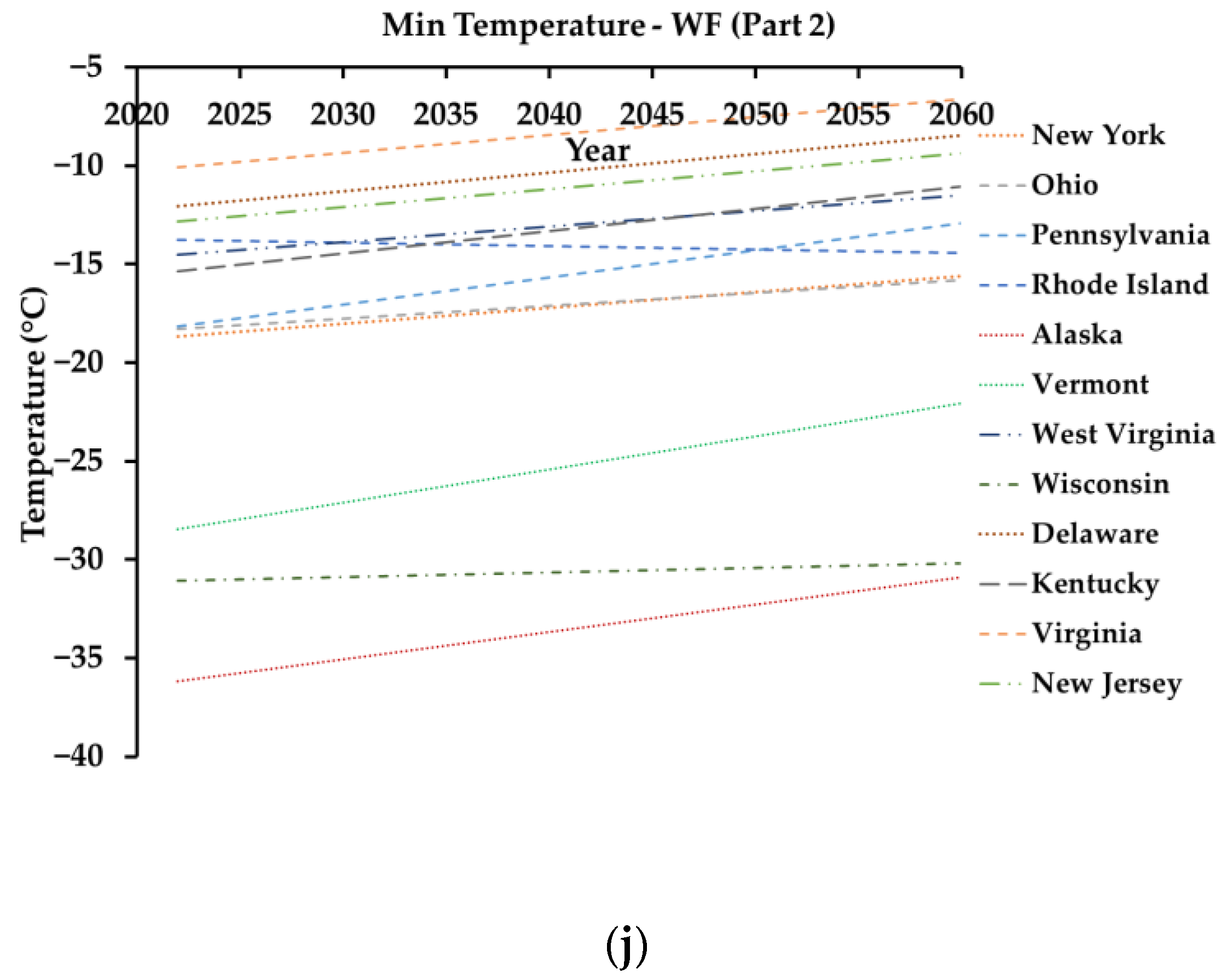
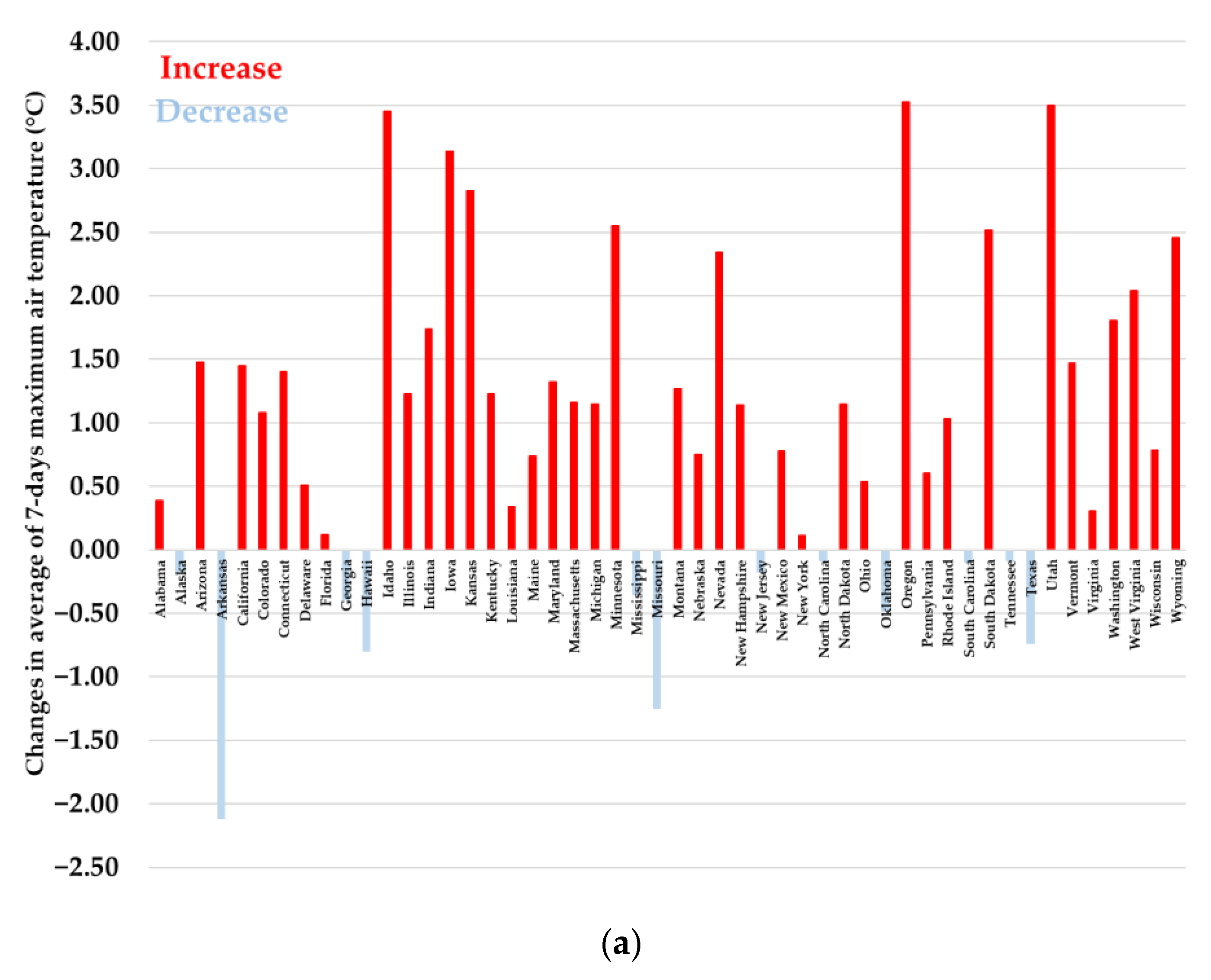
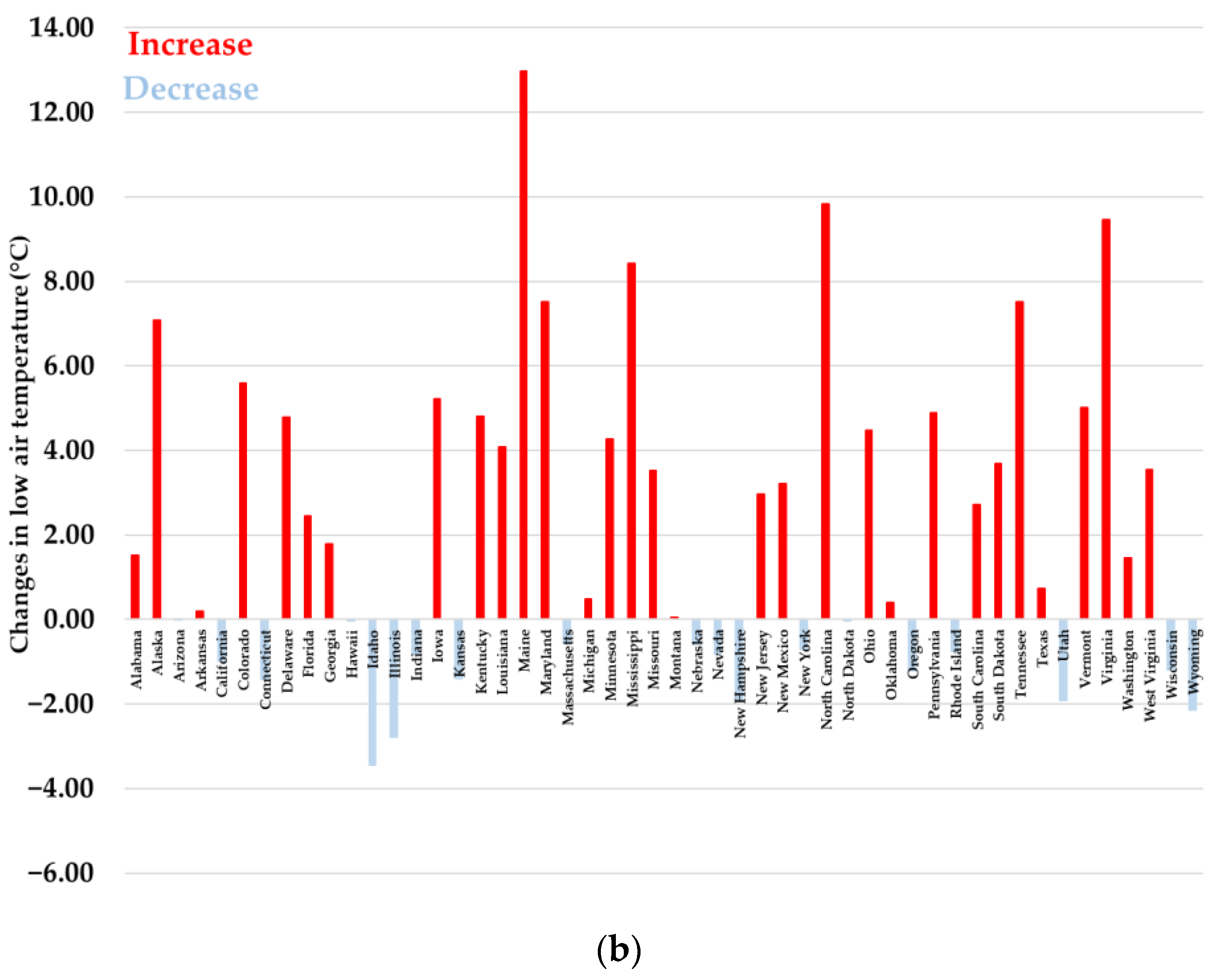
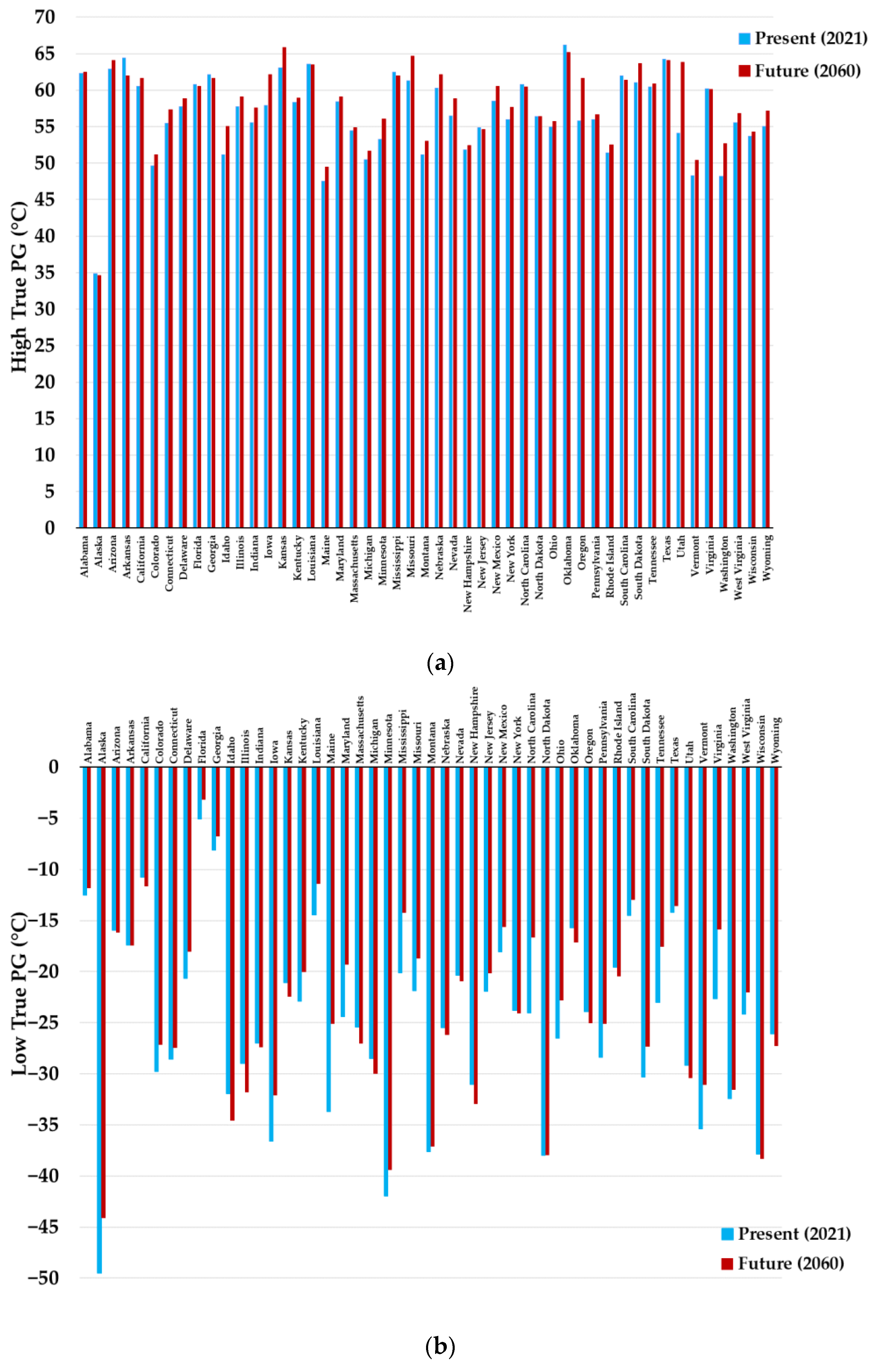

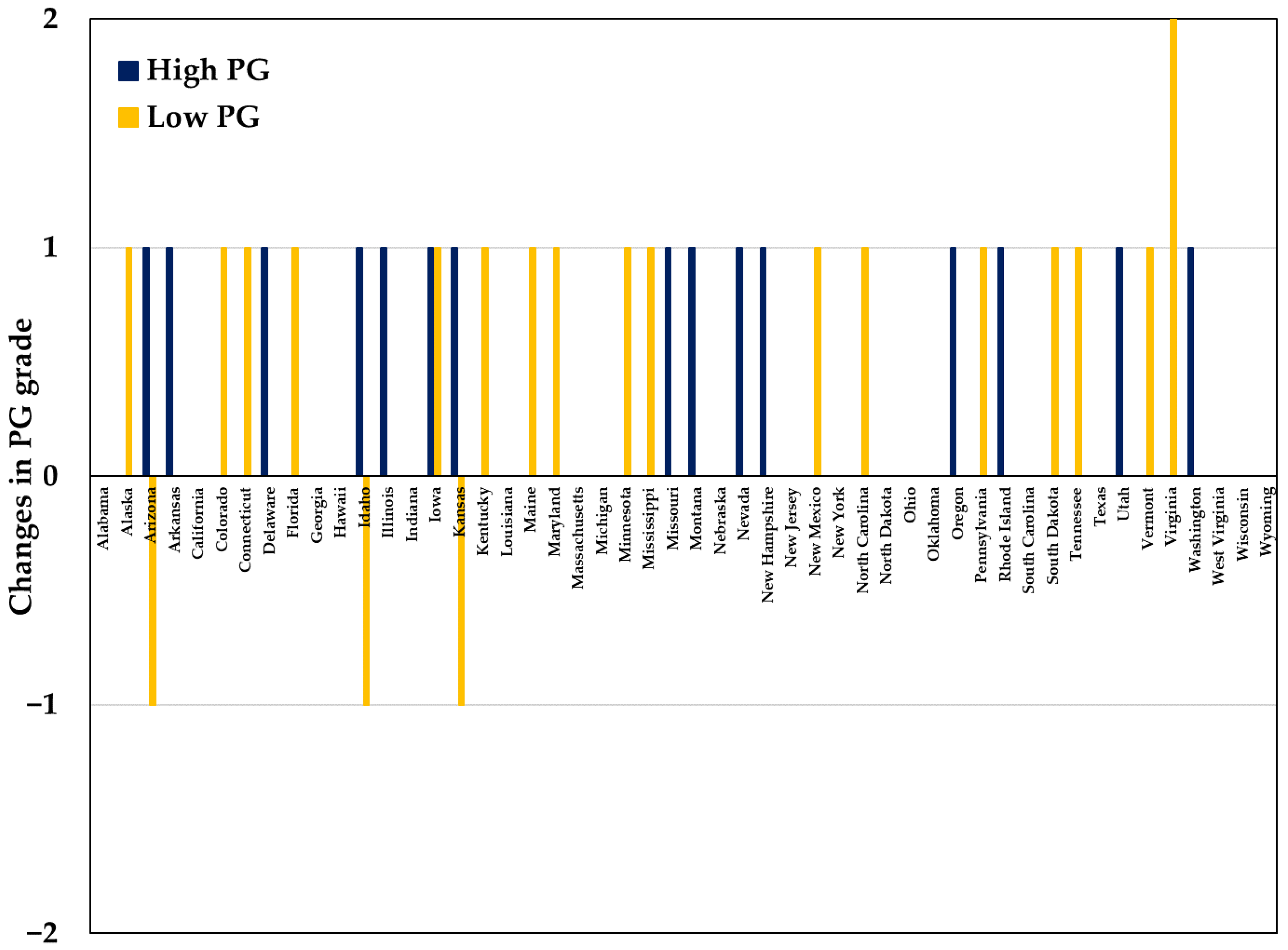
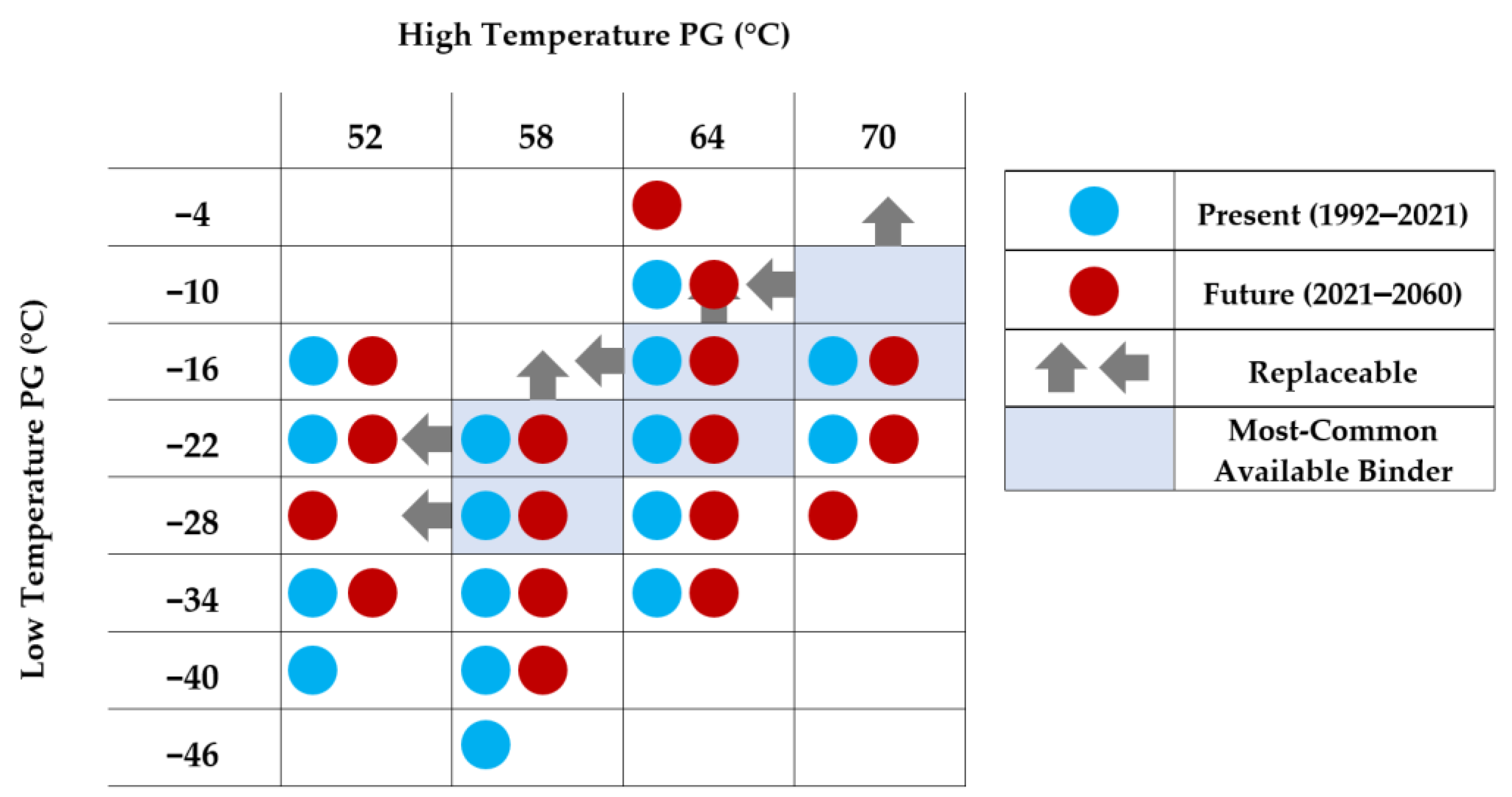
| State | Latitude (Degree) | Longitude (Degree) | State | Longitude (Degree) | Latitude (Degree) |
|---|---|---|---|---|---|
| Alabama | 32.32 | −86.90 | Montana | −110.36 | 46.88 |
| Alaska | 64.20 | −149.49 | Nebraska | −99.90 | 41.49 |
| Arizona | 34.05 | −111.09 | Nevada | −116.42 | 38.80 |
| Arkansas | 34.56 | −92.29 | New Hampshire | −71.57 | 43.19 |
| California | 36.78 | −119.42 | New Jersey | −74.41 | 40.06 |
| Colorado | 39.55 | −105.78 | New Mexico | −105.87 | 34.52 |
| Connecticut | 41.60 | −73.09 | New York | −73.94 | 40.73 |
| Delaware | 38.91 | −75.53 | North Carolina | −79.02 | 35.76 |
| Florida | 27.66 | −81.52 | North Dakota | −101.00 | 47.55 |
| Georgia | 32.17 | −82.90 | Ohio | −82.91 | 40.42 |
| Hawaii | 19.90 | −155.58 | Oklahoma | −97.09 | 35.01 |
| Idaho | 44.07 | −114.74 | Oregon | −120.55 | 43.80 |
| Illinois | 40.63 | −89.40 | Pennsylvania | −77.19 | 41.20 |
| Indiana | 40.27 | −86.13 | Rhode Island | −71.48 | 41.58 |
| Iowa | 41.88 | −93.10 | South Carolina | −81.16 | 33.84 |
| Kansas | 39.01 | −98.48 | South Dakota | −99.90 | 43.97 |
| Kentucky | 37.84 | −84.27 | Tennessee | −86.58 | 35.52 |
| Louisiana | 30.98 | −91.96 | Texas | −99.90 | 31.97 |
| Maine | 45.25 | −69.45 | Utah | −111.09 | 39.32 |
| Maryland | 39.05 | −76.64 | Vermont | −72.58 | 44.56 |
| Massachusetts | 42.41 | −71.38 | Virginia | −78.66 | 37.43 |
| Michigan | 44.31 | −85.60 | Washington | −120.74 | 47.75 |
| Minnesota | 46.73 | −94.69 | West Virginia | −80.45 | 38.60 |
| Mississippi | 32.35 | −89.40 | Wisconsin | −88.79 | 43.78 |
| Missouri | 37.96 | −91.83 | Wyoming | −107.29 | 43.08 |
| Climatic Region (State) | Year | Latitude (Degree) | Average of 7-Day Max Air Temp. (°C) | Min Air Temp. (°C) | High True PG (°C) | Low True PG (°C) | ||
|---|---|---|---|---|---|---|---|---|
| T | σ | T | σ | Reliability 98% | ||||
| Wet No-Freeze (Florida) | 2021 | 27.66 | 35.16 | 1.61 | −5.60 | 2.09 | 60.80 | −5.06 |
| 2060 | 35.28 | 1.43 | −2.95 | 1.93 | 60.55 | −3.17 | ||
| Wet Freeze (Iowa) | 2021 | 41.88 | 32.39 | 2.84 | −39.50 | 4.83 | 57.90 | −36.62 |
| 2060 | 35.52 | 3.45 | −34.28 | 4.20 | 62.12 | −32.08 | ||
| Dry Freeze (Utah) | 2021 | 39.32 | 29.96 | 1.77 | −32.70 | 3.39 | 54.12 | −29.16 |
| 2060 | 33.46 | 4.94 | −34.60 | 3.26 | 63.80 | −30.38 | ||
| Dry No-Freeze (California) | 2021 | 36.78 | 37.12 | 1.25 | −10.70 | 1.49 | 60.49 | −10.77 |
| 2060 | 38.57 | 1.14 | −11.70 | 1.69 | 61.65 | −11.62 | ||
| Climatic Region (State) | Year | Required PG (Reliability 98%) |
|---|---|---|
| Wet No-Freeze (Florida) | 2021 | 64-10 |
| 2060 | 64-4 | |
| Wet Freeze (Iowa) | 2021 | 58-40 |
| 2060 | 64-34 | |
| Dry Freeze (Utah) | 2021 | 58-34 |
| 2060 | 64-34 | |
| Dry No-Freeze (California) | 2021 | 64-16 |
| 2060 | 64-16 |
| Parameters | CR [40] | SBS [40] | PPA [41,42] | Gilsonite [43] |
|---|---|---|---|---|
| Energy consumption (kWh) | 639 | 21,274 | 10,000–20,000 | 500–800 |
| CO2 emissions (kg) | 510 | 4015.43 | 2500–4500 | 100–150 |
| Modifiers | Weight (kg) | Energy Consumption (kWh) | CO2 Emissions (kg) |
|---|---|---|---|
| CR (20%) | 10 | 6.39 | 5.10 |
| SBS (5%) | 2.5 | 53.18 | 10.03 |
| PPA (1.5%) | 0.75 | 7.50–15.00 | 1.87–3.37 |
| Gilsonite (8%) | 4 | 2.00–3.20 | 0.40–0.60 |
Disclaimer/Publisher’s Note: The statements, opinions and data contained in all publications are solely those of the individual author(s) and contributor(s) and not of MDPI and/or the editor(s). MDPI and/or the editor(s) disclaim responsibility for any injury to people or property resulting from any ideas, methods, instructions or products referred to in the content. |
© 2024 by the authors. Licensee MDPI, Basel, Switzerland. This article is an open access article distributed under the terms and conditions of the Creative Commons Attribution (CC BY) license (https://creativecommons.org/licenses/by/4.0/).
Share and Cite
Sepaspour, R.; Zebarjadian, F.; Ehsani, M.; Hajikarimi, P.; Moghadas Nejad, F. Global Warming and Its Effect on Binder Performance Grading in the USA: Highlighting Sustainability Challenges. Infrastructures 2024, 9, 109. https://doi.org/10.3390/infrastructures9070109
Sepaspour R, Zebarjadian F, Ehsani M, Hajikarimi P, Moghadas Nejad F. Global Warming and Its Effect on Binder Performance Grading in the USA: Highlighting Sustainability Challenges. Infrastructures. 2024; 9(7):109. https://doi.org/10.3390/infrastructures9070109
Chicago/Turabian StyleSepaspour, Reza, Faezeh Zebarjadian, Mehrdad Ehsani, Pouria Hajikarimi, and Fereidoon Moghadas Nejad. 2024. "Global Warming and Its Effect on Binder Performance Grading in the USA: Highlighting Sustainability Challenges" Infrastructures 9, no. 7: 109. https://doi.org/10.3390/infrastructures9070109






